
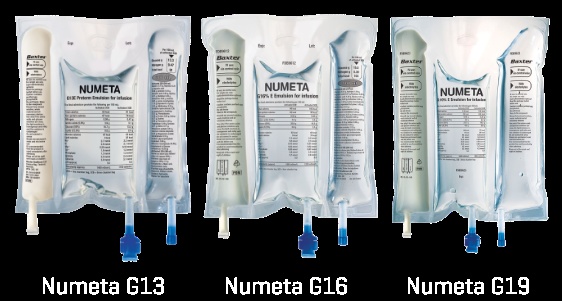
НУМЕТА G16%E, ЕМУЛЬСІЯ ДЛЯ ІНФУЗІЙ

Запитайте лікаря про рецепт на НУМЕТА G16%E, ЕМУЛЬСІЯ ДЛЯ ІНФУЗІЙ

Інструкція із застосування НУМЕТА G16%E, ЕМУЛЬСІЯ ДЛЯ ІНФУЗІЙ
Вступ
Опис: інформація для користувача
NUMETA G16%E емульсія для перфузії
Перед тим, як почати використовувати цей лікарський засіб, уважно прочитайте весь опис, оскільки він містить важливу інформацію для вас.
- Збережіть цей опис, оскільки вам може знадобитися знову його прочитати.
- Якщо у вас виникнуть будь-які питання, проконсультуйтеся з лікарем, фармацевтом або медсестрою вашої дитини.
- Якщо ваша дитина відчуває побічні ефекти, проконсультуйтеся з лікарем, фармацевтом або медсестрою вашої дитини, навіть якщо це побічні ефекти, які не вказані в цьому описі. Див. розділ 4.
Зміст опису:
- Що таке Numeta G16%E і для чого він використовується
- Що потрібно знати перед тим, як Numeta G16%E буде введено вашій дитині
- Як буде введено Numeta G16%E
- Можливі побічні ефекти
- Зберігання Numeta G16%E
- Зміст упаковки та додаткова інформація
1. Що таке Numeta G16%E і для чого він використовується
Numeta G16%E - це спеціалізоване харчування, призначене для новонароджених дітей та дітей до 2 років. Його вводять через трубку, підключену до вени вашої дитини, коли вона не може споживати всі необхідні харчові речовини через рот
Numeta представлений у вигляді трикамерної сумки з трьома незалежними відсіками, які містять:
розчин глюкози 50%
педіатричний розчин амінокислот 5,9% з електролітами
емульсія ліпідів (жирів) 12,5%
В залежності від потреб вашої дитини, дві (або три) з цих розчинів змішуються в сумці перед тим, як їх введуть вашій дитині.
Numeta G16%E повинен використовуватися лише під медичним наглядом.
2. Що потрібно знати перед тим, як Numeta G16%E буде введено вашій дитині
Не використовуйтеNumetaG16%E у наступних випадках:
З двома розчинами, змішаними в сумці (“2 у1”):
- Якщо ваша дитина алергічна на будь-які білки яєць, сої або арахісу чи на інгредієнти сумки з глюкозою або амінокислотами (перелічені у розділі 6).
- Якщо організм вашої дитини має проблеми з використанням компонентів білків.
- Якщо у вашої дитини високі концентрації будь-яких з електролітів, що входять до складу Numeta G16%E.
- Якщо ваша дитина - новонароджена (≤ 28 днів життя) Numeta G16%E (або інші розчини, що містять кальцій) не повинні вводитися одночасно з антибіотиком цефтріаксоном, навіть якщо використовуються окремі лінії для перфузії. Існує ризик утворення частинок у крові новонародженої, що може бути смертельним)
- Якщо у вашої дитини гіперглікемія (спеціально високі рівні цукру у крові).
З трьома розчинами, змішаними в сумці (“3 у1”).
- Усі ситуації, перелічені у “2 у 1”, а також:
- Якщо у вашої дитини особливо високий рівень жирів у крові.
У всіх випадках лікар вирішить, чи слід вводити цей лікарський засіб вашій дитині, виходячи з таких факторів, як вік, вага та клінічний стан, разом з результатами всіх проведених досліджень.
Попередження та обережність
Проконсультуйтеся з лікарем або медсестрою вашої дитини перед тим, як буде введено Numeta G16%E.
Коли цей лікарський засіб використовується у новонароджених та дітей до 2 років, емульсія (у сумках та обладнанні для введення) повинна бути захищена від дії світла до закінчення введення. Дія світла на Numeta G16%E, особливо після змішування з олігоелементами або вітамінами, призводить до утворення пероксидів та інших продуктів розкладу, які можуть бути зменшені, якщо лікарський засіб захищати від дії світла.
Алергічні реакції
Перфузію необхідно негайно зупинити, якщо з'являються будь-які ознаки або симптоми алергічної реакції (такі як гарячка, потіння, озноб, головний біль, висипання на шкірі або труднощі з диханням). Цей лікарський засіб містить соєвий олій, який рідко може спричиняти реакції гіперчутливості. У рідких випадках спостерігалося, що деякі особи, які алергічні на білки арахісу, також алергічні на білки сої.
Numeta G16%E містить глюкозу, отриману з кукурудзяного крохмалю, тому його слід використовувати з обережністю у пацієнтів з відомою алергією на кукурудзу або її продукти.
Ризик утворення частинок з цефтріаксоном (антибіотиком):
Не слід змішувати чи вводити антибіотик цефтріаксон одночасно з розчином, що містить кальцій (включаючи Numeta G16%E), через перфузійну лінію.
Лікар знає про це та не вводить їх одночасно, навіть якщо використовуються окремі лінії або окремі місця перфузії.
Однак лікар може вводити кальцій та цефтріаксон послідовно один за одним, якщо використовуються лінії інфузії в різних точках, або якщо перфузійні лінії заміняються або ретельно промиваються фізіологічним розчином, щоб уникнути утворення осадів.
Утворення малих частинок у кровоносних судинах легень:
Труднощі з диханням також можуть бути ознакою утворення малих частинок, які блокують кровоносні судини легень (васкулярні осади легень). Якщо ваша дитина відчуває труднощі з диханням, повідомте про це лікаря або медсестру вашої дитини. Вони вирішать, які заходи слід вжити.
Інфекція та сепсис
Лікар буде уважно спостерігати за вашою дитиною, щоб виявити будь-які симптоми інфекції. Застосування асептичної техніки (техніки без мікробів) при встановленні та підтримці катетера, а також при підготовці харчової формули, може зменшити ризик інфекції.
Іноді діти можуть розвивати інфекції та сепсис (бактерії у крові), коли в них встановлений внутрішньовенний катетер. Деякі лікарські засоби та захворювання можуть збільшити ризик розвитку сепсису або інфекції. Пацієнти, які потребують парентерального харчування (харчування, введеного через трубку, підключену до вени вашої дитини), мають більшу ймовірність розвитку інфекції через свій клінічний стан.
Синдром надмірної кількості жирів
Відомі випадки синдрому надмірної кількості жирів з аналогічними продуктами. Зниження здатності до виведення ліпідів, що містяться у Numeta G16%E, або передозування може призвести до розвитку "синдрому надмірної кількості жирів" (див. розділи 3 та 4 Можливі побічні ефекти).
Зміна рівнів хімічних речовин у крові
Лікар буде перевіряти та коригувати рідини в організмі, рівні хімічних речовин у крові та інші рівні у крові вашої дитини, оскільки іноді реабілітація особи, яка сильно недоїдає, може призвести до змін у рівнях хімії крові. Також може виникнути надмірна кількість рідини в тканинах та набухання. Рекомендується розпочинати парентеральне харчування повільно та під наглядом.
Високі рівні магнію у крові
Кількість магнію, присутня у Numeta G16%E, може призвести до високих рівнів магнію у крові. Серед ознак цих високих рівнів - слабкість, сповільнення рефлексів, нудота, блювота, низькі рівні кальцію у крові, труднощі з диханням, низький артеріальний тиск та нерегулярні серцеві скорочення. Оскільки може бути важко виявити ці ознаки, лікар може контролювати рівні магнію у крові вашої дитини, особливо якщо ваша дитина має фактори ризику, пов'язані з високими рівнями магнію у крові, включаючи порушення функції нирок. Якщо рівні магнію у крові високі, перфузію буде зупинено або зменшено.
Нагляд та коригування
Лікар буде спостерігати та коригувати дозу Numeta G16%E, щоб вона відповідала індивідуальним потребам вашої дитини, якщо вона має такі стани:
- важкий післятравматичний стан
- важкий цукровий діабет
- шок
- інфаркт
- важка інфекція
- певні види коми
Застосування з обережністю:
Numeta G16%E повинен застосовуватися з обережністю, якщо ваша дитина має:
- легеневу водянку (рідину в легенях) або серцеву недостатність,
- важкі порушення функції печінки,
- проблеми з засвоєнням харчових речовин,
- високі рівні цукру,
- проблеми з нирками,
- важкі метаболічні порушення (коли організм не може виводити речовини正常но),
- порушення згортання крові.
Рівні рідини в організмі вашої дитини, значення аналізу крові та інші значення у крові будуть ретельно контролюватися.
Застосування Numeta G16%E з іншими лікарськими засобами
Повідомте лікаря, якщо ваша дитина використовує, нещодавно використовувала або може використовувати інші лікарські засоби.
Numeta G16%Eне повинен вводитися одночасно з:
- цефтріаксоном(антибіотиком) навіть через окремі лінії перфузії, через ризик утворення частинок.
- кров'ючерез ту саму лінію перфузії. Через ризик псевдоаглютинації (червоні кров'яні тіла стають пірамідальними)
- ампіциліном,фосфенітоїном та фуросемідомчерез ту саму лінію перфузії, оскільки існує ризик утворення частинок.
Кумарин та варфарин (антикоагулянти)
Лікар буде уважно спостерігати за вашою дитиною, якщо вона приймає кумарин або варфарин. Оливкова олія та соєва олія містять вітамін К1. Вітамін К1 може впливати на дію лікарських засобів, таких як кумарин та варфарин. Ці лікарські засоби є антикоагулянтами, які використовуються для запобігання згортанню крові.
Лабораторні дослідження
Ліпіди, що входять до складу цієї емульсії, можуть впливати на результати деяких лабораторних досліджень. Лабораторні дослідження можна проводити після періоду 5-6 годин, якщо не вводяться додаткові ліпіди.
Взаємодія Numeta G16%Eз лікарськими засобами, які можуть впливати на рівні/метаболізм калію:
Numeta G16%E містить калій. Високі рівні калію у крові можуть призвести до аномального серцевого ритму. Спеціальну увагу слід приділити пацієнтам, які приймають діуретики (лікарські засоби, які зменшують утримання рідини), інгібітори АПФ або антагоністи рецептора II ангіотензину (всі ці лікарські засоби використовуються для лікування підвищеного артеріального тиску) або імунодепресанти (лікарські засоби, які можуть зменшувати природні захисні сили організму). Ці лікарські засоби можуть збільшувати рівні калію.
3. Як буде введено Numeta G16%E
Вашій дитині завжди повинні вводити Numeta G16%E точно так, як вказав лікар. Проконсультуйтеся з лікарем, якщо у вас виникли питання.
Вік
Numeta G16%E призначений для задоволення харчових потреб новонароджених дітей та дітей до 2 років.
Лікар вирішить, чи підходить цей лікарський засіб для вашої дитини.
Введення
Цей лікарський засіб є емульсією для перфузії. Його вводять через пластикову трубку, підключену до вени на руці або великої вени на грудях вашої дитини.
Лікар вашої дитини може вирішити не вводити ліпіди вашій дитині. Конструкція сумки Numeta G16%E дозволяє розірвати тільки нестійке з'єднання між відсіками з амінокислотами/електролітами та глюкозою, якщо це необхідно. З'єднання між відсіками з амінокислотами та ліпідами залишається цілим у цьому випадку. Зміст сумки можна перфундувати без ліпідів.
Коли цей лікарський засіб використовується у новонароджених та дітей до 2 років, емульсія (у сумках та обладнанні для введення) повинна бути захищена від дії світла до закінчення введення (див. розділ 2).
Дозування та тривалість лікування
Лікар вашої дитини вирішить, яку дозу потрібно вашій дитині, та як довго її буде вводити. Дозування залежить від харчових потреб вашої дитини та базується на її вазі, медичному стані та здатності організму до засвоєння інгредієнтів Numeta G16%E. Також можуть вводитися додаткові білки або харчування через рот або шлунково-кишковий тракт.
Якщо вашій дитині буде введено більшеNumetaG16%E, ніж потрібно
У разі передозування або випадкового прийому проконсультуйтеся з Токсикологічною службою. Телефон 915.620.420
Симптоми
Отримання надмірної кількості лікарського засобу або його введення занадто швидко може призвести до:
- нудоти (відчуття нездоров'я)
- блювоти
- ознобу
- електролітних порушень (неправильних рівнів електролітів у крові)
- ознак гіперволемії (збільшення об'єму циркулюючої крові)
- ацидозу (збільшення кислотності крові)
У цих випадках перфузію необхідно негайно зупинити. Лікар вашої дитини вирішить, чи потрібно вжити інші заходи.
Передозування жирів, що входять до складу Numeta G16%E, може призвести до розвитку "синдрому надмірної кількості жирів", який зазвичай є оборотним після припинення інфузії. У новонароджених (неонатів) та маленьких дітей (немовлят) синдром надмірної кількості жирів асоціюється з респіраторними розладами, які призводять до зниження рівня оксигену в організмі (труднощі з диханням) та станами, які призводять до збільшення кислотності крові (ацидоз).
Щоб уникнути цих реакцій, лікар вашої дитини буде регулярно спостерігати за станом вашої дитини та аналізувати її рівні крові під час лікування.
4. Можливі побічні ефекти
Як і всі лікарські засоби, цей лікарський засіб може призвести до побічних ефектів, хоча не всі діти їх відчувають.
Якщо ви помітите будь-які зміни в стані вашої дитини під час лікування або після нього, негайно повідомте про це лікаря або медсестру.
Дослідження, які лікар проведе у вашої дитини під час лікування цим лікарським засобом, повинні мінімізувати ризик побічних ефектів.
Якщо з'являються симптоми алергічної реакції, перфузію необхідно зупинити та негайно звернутися до лікаря. Це може бути серйозним, а симптоми можуть включати:
- Потіння.
- Озноб.
- Головний біль.
- Висипання на шкірі.
- Труднощі з диханням.
Інші побічні ефекти, які спостерігалися, включають:
Часті: можуть впливати до 1 з 10 осіб
- Низький рівень фосфату у крові (гіпофосфатемія).
- Високий рівень цукру у крові (гіперглікемія).
- Високий рівень кальцію у крові (гіперкальціємія).
- Високий рівень тригліцеридів у крові (гіпертригліцеридемія).
- Електролітні порушення (гіпонатріємія).
Рідкі: можуть впливати до 1 з 100 осіб
- Високий рівень ліпідів у крові (гіперліпідемія).
- Розлад, при якому жовч не може текти з печінки до дванадцятипалої кишки (холестаз). Дванадцятипала кишка - частина кишечника.
Невідомі: частота не може бути оцінена з наявних даних (ці побічні ефекти були повідомлені для Numeta G13%E та G16%E, коли вони вводилися через периферичну вену з недостатньою розведенням).
- Некроз шкіри
- Ушкодження м'яких тканин
- Екстравазація
Було повідомлено про наступні побічні ефекти з іншими продуктами для парентерального харчування:
- Зниження здатності до виведення ліпідів, що входять до складу Numeta, може призвести до розвитку "синдрому надмірної кількості жирів". Наступні ознаки та симптоми цього синдрому зазвичай є оборотними після припинення інфузії ліпідної емульсії:
- Раптове та різке погіршення стану пацієнта.
- Високий рівень жирів у крові (гіперліпідемія).
- Гарячка.
- Жирове інфільтрування печінки (гепатомегалія).
- Погіршення функції печінки.
- Зниження рівня червоних кров'яних тілець, що може призвести до блідості шкіри та спричинити слабкість або труднощі з диханням (анемія).
- Низький рівень білих кров'яних тілець, що може збільшити ризик інфекції (лейкоцитопенія).
- Низький рівень тромбоцитів, що може збільшити ризик гематом та/або кровотеч (тромбоцитопенія).
- Розлади згортання крові, які впливають на здатність крові згортатися
- Респіраторний розлад, який призводить до зниження рівня оксигену в організмі (труднощі з диханням)
- Стани, які призводять до збільшення кислотності крові (ацидоз)
- Стан коми, який потребує госпіталізації.
- Утворення малих частинок, які можуть призвести до блокування кровоносних судин легень (васкулярні осади легень) або труднощі з диханням.
Повідомлення про побічні ефекти:
Якщо ваша дитина відчуває будь-який побічний ефект, проконсультуйтеся з лікарем або медсестрою, навіть якщо це побічні ефекти, які не вказані в цьому описі. Також можна повідомити про них безпосередньо через Іспанську систему фармакологічного нагляду за лікарськими засобами для людини: https://www.notificaram.es. Повідомляючи про побічні ефекти, ви можете допомогти надати більше інформації про безпеку цього лікарського засобу.
5. Зберігання Numeta G16%E
Тримайте цей лікарський засіб поза зоною видимості та досягнення дітей, коли він не вводиться.
Коли цей лікарський засіб використовується у новонароджених та дітей до 2 років, емульсія (у сумках та обладнанні для введення) повинна бути захищена від дії світла до закінчення введення (див. розділ 2).
Не використовуйте цей лікарський засіб після закінчення терміну придатності, вказаного на сумці та зовнішній упаковці (ММ/РРРР). Термін придатності - останній день місяця, який вказано.
Не заморожуйте.
Тримайте у зовнішній сумці.
Лікарські засоби не повинні викидатися у каналізацію чи сміття. Спитайте у фармацевта, як позбутися упаковок та лікарських засобів, які вам більше не потрібні. Таким чином, ви допоможете захистити довкілля.
6. Зміст упаковки та додаткова інформація
Вигляд продукту та вміст упаковки
Numeta G16%E випускається у вигляді мішка з трьома відділами. Кожен мішок містить стерильну суміш розчину глюкози, педіатричного розчину амінокислот з електролітами та емульсії ліпідів, як описано нижче:
Розмір упаковки | Розчин глюкози 50% | Розчин амінокислот 5,9% з електролітами | Емульсія ліпідів 12,5% |
500 мл | 155 мл | 221 мл | 124 мл |
Вигляд до реконституції:
- Розчини амінокислот і глюкози прозорі, безбарвні або легенько жовтуваті.
- Відділ емульсії ліпідів має молочний вигляд і білуватий колір.
Вигляд після реконституції:
- Розчин "2 у 1" прозорий, безбарвний або легенько жовтуватий.
- Емульсія для перфузії "3 у 1" має однорідний молочний вигляд і білуватий колір.
Мішок з трьома відділами є багатошаровим пластиковим мішком.
Для уникнення контакту з повітрям Numeta упаковується всередині бар'єрної оболонки, яка містить пакетик з абсорбентом кисню та індикатором кисню.
Розміри упаковки
Мішок об'ємом 500 мл: 6 одиниць у коробці
1 мішок об'ємом 500 мл
Можливо, що тільки деякі розміри упаковки будуть випускатися.
Власник дозволу на маркетинг та відповідальна особа за виробництво
Власник дозволу на маркетинг
Baxter, S.L.
Pouet de Camilo 2, 46394 Ribarroja del Turia (Валенсія)
Відповідальна особа за виробництво
Baxter S.A.
Boulevard Rene Branquart, 80
7860 Lessines
Бельгія
Цей лікарський засіб дозволений у країнах-членах Європейського економічного простору під наступними назвами:
Австрія Німеччина | Numeta G16 % E Emulsion zur Infusion |
Бельгія Люксембург | Numetzah G16%E, émulsion pour perfusion |
Франція | Numetah G16 %E émulsion pour perfusion |
Данія Норвегія Швеція | Numeta G16E |
Чехія Греція | Numeta G16 % E |
Нідерланди | Numeta G16%E emulsie voor infusie |
Ірландія Велика Британія | Numeta G16%E, Emulsion for Infusion |
Італія | Numeta G16%E emulsione per infusione |
Фінляндія | Numeta G16E infuusioneste, emulsio |
Польща | Numeta G16 % E |
Португалія | Numeta G16%E |
Іспанія | Numeta G16%E, emulsión para perfusión |
Дата останнього перегляду цієї інструкції: Травень 2024
Детальна та актуальна інформація про цей лікарський засіб доступна на сайті Іспанського агентства лікарських засобів та медичних продуктів (AEMPS) http://www.aemps.gob.es/
---------------------------------------------------------------------------------------------------------------------
Ця інформація призначена лише для медичних працівників:
(*) Будьте уважні, що в деяких випадках ці лікарські засоби можуть бути введені вдома батьками чи іншими опікунами. У таких випадках батьки/опікуни повинні прочитати наступну інформацію.
Не слід додавати жодного лікарського засобу до мішка без попередньої перевірки його сумісності. Можуть утворюватися частинки або розкладатися емульсія ліпідів, що може блокувати кровоносні судини.
Numeta G16%E повинна бути при кімнатній температурі перед використанням.
Перед введенням Numeta G16%E слід підготувати мішок наступним чином.
Перевірте, чи не пошкоджений мішок, і використовуйте його лише якщо він не пошкоджений. Непошкоджений мішок має такий вигляд:
- Непостійні пломби цілі. Це видно тому, що немає змішування трьох відділів.
- Розчин амінокислот і глюкози прозорий, безбарвний або легенько жовтуватий і без видимих частинок.
- Емульсія ліпідів має молочний вигляд і білуватий колір.
Перед відкриттям бар'єрної оболонки перевірте колір абсорбента кисню.
- Порівняйте його з кольором еталона, надрукованим поряд з символом OK і показаним у друкарській зоні мітки індикатора.
- Не використовуйте продукт, якщо колір абсорбента кисню не відповідає кольору еталона, надрукованому поряд з символом OK.
Фігури 1 і 2 показують, як видалити бар'єрну оболонку. Витратьте її разом з індикатором кисню та абсорбентом кисню.
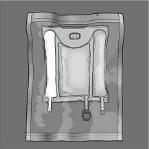

Фігура 1 Фігура 2
Підготовка суміші
- Перевірте, чи продукт знаходиться при кімнатній температурі перед відкриттям непостійних пломб.
- Помістіть мішок на чисту і пласку поверхню.
Активація мішка з трьома відділами (відкриття двох непостійних пломб)
Пункт 1: Зверніть мішок з боку кронштейна у вигляді букви D
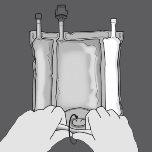
Пункт 2: Натисніть до тих пір, поки не відкриються непостійні пломби.

Пункт 3: Змініть напрямок і зверніть мішок до кронштейна у вигляді букви D, поки пломба не відкриється повністю. Виконайте ті самі дії для відкриття другого непостійного пломба.

Пункт 4: Переверніть мішок щонайменше три рази, щоб добре перемішати вміст. Вигляд суміші повинен бути білою молочною емульсією.
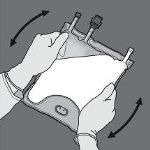
Пункт 5: Видаліть захисний ковпачок з місця введення та вставьте обладнання для внутрішньовенної інфузії.

Активація мішка з двома відділами (відкриття непостійної пломби між відділами амінокислот і глюкози)
Пункт 1: Для відкриття лише непостійної пломби амінокислот/глюкози почніть звертати мішок з кута кронштейна у вигляді букви D, що розділяє відділи амінокислот і глюкози, і натисніть, щоб відкрити пломбу, що розділяє обидва відділи.
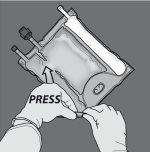
Пункт 2: Помістіть мішок так, щоб відділ з емульсією ліпідів був звернений до оператора, і зверніть мішок, захищаючи відділ з емульсією ліпідів у долоні рук.
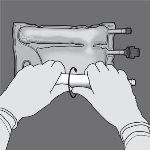
Пункт 3: Однією рукою застосуйте тиск, звертаючи мішок до трубок.

Пункт 4: Далі змініть напрямок і зверніть мішок до кронштейна у вигляді букви D, натискаючи іншою рукою, поки пломба, що розділяє розчини амінокислот і глюкози, не відкриється повністю.

Пункт 5: Переверніть мішок щонайменше три рази, щоб добре перемішати вміст. Вигляд суміші повинен бути прозорим, безбарвним або легенько жовтуватим.

Пункт 6: Видаліть захисний ковпачок з місця введення та вставьте обладнання для внутрішньовенної інфузії.

Швидкість введення повинна поступово збільшуватися протягом першої години та регулюватися залежно від наступних факторів:
Доза, що вводиться
Щоденний об'єм
Тривалість перфузії.
Спосіб введення
Коли використовується у новонароджених та дітей молодше 2 років, емульсію (у мішку та обладнанні для введення) слід захистити від світла до закінчення введення.
Рекомендується використовувати фільтр з діаметром пор 1,2 мкм для введення Numeta G16%E.
Через високу осмолярність Numeta G16%E можна вводити без розбавлення лише через центральну вену; однак відповідне розбавлення Numeta G16%E водою для ін'єкцій знижує осмолярність і дозволяє периферичну перфузію.
Наступна формула показує вплив розбавлення на осмолярність мішків.
Остаточна осмолярність | = | Об'єм мішка х початкова осмолярність |
Додана вода + об'єм мішка |
Наступна таблиця показує приклади осмолярності для додавання мішків з двома та трьома відділами після додавання води для ін'єкцій:
Амінокислоти та глюкоза(B2C активовані) | Амінокислоти, глюкоза таліпіди (B3C активовані) | |
Початковий об'єм у мішку (мл) | 376 | 500 |
Початкова осмолярність (мОсм/л приблизно) | 1585 | 1230 |
Об'єм доданої води (мл) | 376 | 500 |
Остаточний об'єм після додавання (мл) | 752 | 1000 |
Остаточна осмолярність після додавання (мОсм/л приблизно) | 792,5 | 615 |
Додавання лікарських засобів
Суміші, що містять олігоелементи та вітаміни, повинні бути захищені від світла, починаючи з місця введення та під час введення. Вплив світла на суміші може привести до утворення пероксидів та інших продуктів розкладання, які можна зменшити за допомогою фотозахисту
Можна додавати сумісні лікарські засоби до реконституйованої суміші (після відкриття непостійних пломб та перемішування вмісту двох або трьох відділів) через місце введення.
Також можна додавати вітаміни до відділу глюкози до реконституції суміші (до відкриття непостійних пломб та перемішування розчинів та емульсії).
У таблицях 1-6 показані можливі додавання комерційно доступних розчинів олігоелементів (позначених як TE1, TE2 та TE4), вітамінів (позначених як лioфілізований V1 та емульсія V2) та електролітів у визначених кількостях.
1 Сумісність з TE4, V1 та V2
Таблиця 1: Сумісність 3-у-1 (B3C активовані) з або без розбавлення водою
На 500 мл (суміш 3 у 1 з ліпідами) | ||||||
Суміш без розбавлення | Суміш з розбавленням | |||||
Додатки | Включений рівень | Максимальне додавання | Максимальний загальний рівень | Включений рівень | Максимальне додавання | Максимальний загальний рівень |
Натрій (ммоль) | 12,0 | 25,6 | 37,6 | 12,0 | 25,6 | 37,6 |
Калій (ммоль) | 11,4 | 26,2 | 37,6 | 11,4 | 26,2 | 37,6 |
Магній (ммоль) | 1,6 | 3,6 | 5,2 | 1,6 | 3,6 | 5,2 |
Кальцій (ммоль) | 3,1 | 16,4 | 19,5 | 3,1 | 8,2 | 11,3 |
Фосфат* (ммоль) | 4,4 | 6,9 | 11,3 | 4,4 | 6,9 | 11,3 |
Олігоелементи та вітаміни | - | 10 мл TE4 + 1 флакон V1 + 30 мл V2 | 10 мл TE4 + 1 флакон V1 + 30 мл V2 | - | 5 мл TE4 + ½ флакону V1 + 5 мл V2 | 5 мл TE4 + ½ флакону V1 + 5 мл V2 |
Вода для ін'єкцій | - | - | - | - | 350 мл | 350 мл |
- Органічний фосфат
Таблиця 2: Сумісність 2-у-1 (B2C активовані) з або без розбавлення водою
На 376 мл (суміш 2 у 1 без ліпідів) | ||||||
Суміш без розбавлення | Суміш з розбавленням | |||||
Додатки | Включений рівень | Максимальне додавання | Максимальний загальний рівень | Включений рівень | Максимальне додавання | Максимальний загальний рівень |
Натрій (ммоль) | 11,6 | 26,0 | 37,6 | 11,6 | 0,0 | 11,6 |
Калій (ммоль) | 11,4 | 26,2 | 37,6 | 11,4 | 0,0 | 11,4 |
Магній (ммоль) | 1,6 | 3,6 | 5,2 | 1,6 | 0,0 | 1,6 |
Кальцій (ммоль) | 3,1 | 8,2 | 11,3 | 3,1 | 0,0 | 3,1 |
Фосфат* (ммоль) | 3,2 | 8,1 | 11,3 | 3,2 | 0,0 | 3,2 |
Олігоелементи та вітаміни | - | 5 мл TE4 + ½ флакону V1 | 5 мл TE4 + ½ флакону V1 | - | 5 мл TE4 + ½ флакону V1 | 5 мл TE4 + ½ флакону V1 |
Вода для ін'єкцій | - | - | - | - | 450 мл | 450 мл |
- Органічний фосфат
2 Сумісність з TE1, V1 та V2
Таблиця 3: Сумісність 3-у-1 (B3C активовані) з або без розбавлення водою
На 500 мл (суміш 3 у 1 з ліпідами) | ||||||
Суміш без розбавлення | Суміш з розбавленням | |||||
Додатки | Включений рівень | Максимальне додавання | Максимальний загальний рівень | Включений рівень | Максимальне додавання | Максимальний загальний рівень |
Натрій (ммоль) | 12,0 | 4,0 | 16,0 | 12,0 | 0,0 | 12,0 |
Калій (ммоль) | 11,4 | 6,2 | 17,6 | 11,4 | 0,0 | 11,4 |
Магній (ммоль) | 1,6 | 0 | 1,6 | 1,6 | 0,0 | 1,6 |
Кальцій (ммоль) | 3,1 | 2,1 | 5,2 | 3,1 | 0,0 | 3,1 |
Фосфат* (ммоль) | 4,4 | 2,0 | 6,4 | 4,4 | 0,0 | 4,4 |
Олігоелементи та вітаміни | - | 5 мл TE1 + ½ флакону V1 + 5 мл V2 | 5 мл TE1 + ½ флакону V1 + 5 мл V2 | - | 5 мл TE1 + ½ флакону V1 + 5 мл V2 | 5 мл TE1 + ½ флакону V1 + 5 мл V2 |
Вода для ін'єкцій | - | - | - | - | 350 мл | 350 мл |
- Органічний фосфат
Таблиця 4: Сумісність 2-у-1 (B2C активовані) з або без розбавлення водою
На 376 мл (суміш 2 у 1 без ліпідів) | ||||||
Суміш без розбавлення | Суміш з розбавленням | |||||
Додатки | Включений рівень | Максимальне додавання | Максимальний загальний рівень | Включений рівень | Максимальне додавання | Максимальний загальний рівень |
Натрій (ммоль) | 11,6 | 26,0 | 37,6 | 11,6 | 0,0 | 11,6 |
Калій (ммоль) | 11,4 | 26,2 | 37,6 | 11,4 | 0,0 | 11,4 |
Магній (ммоль) | 1,6 | 3,6 | 5,2 | 1,6 | 0,0 | 1,6 |
Кальцій (ммоль) | 3,1 | 8,2 | 11,3 | 3,1 | 0,0 | 3,1 |
Фосфат* (ммоль) | 3,2 | 8,1 | 11,3 | 3,2 | 0,0 | 3,2 |
Олігоелементи та вітаміни | - | 5 мл TE1 + ½ флакону V1 | 5 мл TE1 + ½ флакону V1 | - | 5 мл TE1 + ½ флакону V1 | 5 мл TE1 + ½ флакону V1 |
Вода для ін'єкцій | - | - | - | - | 450 мл | 450 мл |
- Органічний фосфат
3 Сумісність з TE2, V1 та V2
Таблиця 5: Сумісність 3-у-1 (B3C активовані) з або без розбавлення водою
На 500 мл (суміш 3 у 1 з ліпідами) | ||||||
Суміш без розбавлення | Суміш з розбавленням | |||||
Додатки | Включений рівень | Максимальне додавання | Максимальний загальний рівень | Включений рівень | Максимальне додавання | Максимальний загальний рівень |
Натрій (ммоль) | 12,0 | 4,0 | 16,0 | 12,0 | 0,0 | 12,0 |
Калій (ммоль) | 11,4 | 6,2 | 17,6 | 11,4 | 0,0 | 11,4 |
Магній (ммоль) | 1,6 | 0 | 1,6 | 1,6 | 0,0 | 1,6 |
Кальцій (ммоль) | 3,1 | 2,1 | 5,2 | 3,1 | 0,0 | 3,1 |
Фосфат* (ммоль) | 4,4 | 2,0 | 6,4 | 4,4 | 0,0 | 4,4 |
Олігоелементи та вітаміни | - | 5 мл TE1 + ½ флакону V1 + 5 мл V2 | 5 мл TE1 + ½ флакону V1 + 5 мл V2 | - | 5 мл TE1 + ½ флакону V1 + 5 мл V2 | 5 мл TE1 + ½ флакону V1 + 5 мл V2 |
Вода для ін'єкцій | - | - | - | - | 350 мл | 350 мл |
- Органічний фосфат
Склад Numeta G16%E
Активні речовини:
Склад | 500 мл | |
Активна речовина | B2C активована (376 мл) | B3C активована (500 мл) |
Відділ амінокислот | ||
Активна речовина | ||
Аланін | 1,03 г | 1,03 г |
Аргінін | 1,08 г | 1,08 г |
Аспарагінова кислота | 0,77 г | 0,77 г |
Цистеїн | 0,24 г | 0,24 г |
Глутамінова кислота | 1,29 г | 1,29 г |
Гліцин | 0,51 г | 0,51 г |
Гістидин | 0,49 г | 0,49 г |
Ізолейцин | 0,86 г | 0,86 г |
Лейцин | 1,29 г | 1,29 г |
Лізин моногідрат (еквівалент Лізину) | 1,59 г (1,42 г) | 1,59 г (1,42 г) |
Метіонін | 0,31 г | 0,31 г |
Орнітин Хл (еквівалент Орнітину) | 0,41 г (0,32 г) | 0,41 г (0,32 г) |
Фенілаланін | 0,54 г | 0,54 г |
Пролін | 0,39 г | 0,39 г |
Серин | 0,51 г | 0,51 г |
Таурин | 0,08 г | 0,08 г |
Треонін | 0,48 г | 0,48 г |
Триптофан | 0,26 г | 0,26 г |
Тирозин | 0,10 г | 0,10 г |
Валін | 0,98 г | 0,98 г |
Хлорид натрію | 0,30 г | 0,30 г |
Ацетат калію | 1,12 г | 1,12 г |
Хлорид кальцію дигідрат | 0,46 г | 0,46 г |
Ацетат магнію тетрагідрат | 0,33 г | 0,33 г |
Гліцерофосфат натрію гідрат | 0,98 г | 0,98 г |
Відділ глюкози | ||
Глюкоза моногідрат (еквівалент глюкози без води) (еквівалент глюкози без води) | 85,25 г (77,50 г) | 85,25 г (77,50 г) |
Відділ ліпідів | ||
Олія сої рафінована (приблизно 80%) + олія оливкова рафінована (приблизно 20%) | - | 15,5 г |
Розчин/емульсія після реконструкції забезпечує наступне:
Склад | |||||
B2C активована | B3C активована | 100 | 500 | 100 | |
На одиницю об'єму (мл) | 376 | 100 | 500 | 100 | |
Азот (г) | 2,0 | 0,52 | 2,0 | 0,39 | |
Амінокислоти (г) | 13,0 | 3,5 | 13,0 | 2,6 | |
Глюкоза (г) | 77,5 | 20,6 | 77,5 | 15,5 | |
Ліпіди (г) | 0 | 0 | 15,5 | 3,1 | |
Енергія | |||||
Калорії загалом (ккал) | 362 | 96 | 517 | 103 | |
Калорії не білкові (ккал) | 310 | 82 | 465 | 93 | |
Калорії глюкози (ккал) | 310 | 82 | 310 | 62 | |
Калорії ліпідів (ккал) | 0 | 0 | 155 | 31 | |
Калорії не білкові/азот (ккал/г N) | 158 | 158 | 237 | 237 | |
Калорії ліпідів (% калорій не білкових) | NA | N/A | 33 | 33 | |
Калорії ліпідів (% калорій загалом) | NA | N/A | 30 | 30 | |
Електроліти | |||||
Натрій (ммоль) | 11,6 | 3,1 | 12,0 | 2,4 | |
Калій (ммоль) | 11,4 | 3,0 | 11,4 | 2,3 | |
Магній (ммоль) | 1,6 | 0,41 | 1,6 | 0,31 | |
Кальцій (ммоль) | 3,1 | 0,82 | 3,1 | 0,62 | |
Фосфат (ммоль) | 3,2 | 0,85 | 4,4 | 0,87 | |
Ацетат (ммоль) | 14,5 | 3,9 | 14,5 | 2,9 | |
Малат (ммоль) | 4,3 | 1,1 | 4,3 | 0,86 | |
Хлорид (ммоль) | 13,8 | 3,7 | 13,8 | 2,8 | |
pH (приблизно) | 5,5 | 5,5 | 5,5 | 5,5 | |
Осмолярність приблизно (мОсм/л) | 1585 | 1585 | 1230 | 1230 |
(а) Включає калорії фосфоліпідів яйця для інфузії.
(б) Включає фосфат, забезпечений фосфоліпідами яйця для інфузії.
Інші компоненти:
Яблучна кислота |
Хлоридна кислота |
Фосфоліпіди яйця для інфузії |
Гліцерол |
Олеат натрію |
Гідроксид натрію |
Вода для ін'єкційних препаратів |
а для регулювання pH
Baxter і Numeta є зареєстрованими торговими марками компанії Baxter International Inc.
- Країна реєстрації
- Діючі речовини
- Потрібен рецептТак
- Виробник
- Інформація є довідковою і не є медичною порадою. Перед прийомом будь-яких препаратів обов'язково проконсультуйтеся з лікарем. Oladoctor не несе відповідальності за медичні рішення, прийняті на основі цього контенту.
- Альтернативи до НУМЕТА G16%E, ЕМУЛЬСІЯ ДЛЯ ІНФУЗІЙФорма випуску: ІН'ЄКЦІЙНИЙ РОЗЧИН ДЛЯ ІНФУЗІЙ, 3,92 г / 1,26 г / 7,21 г / 3,36 г / 4,2 г / 5,11 г / 2,94 г / 2,8 г / 4,76 г / 5,07 г / 4,06 г / 14,49 г / 0,28 г / 8,05 г / 3,5 г / 200 гДіючі речовини: combinationsВиробник: Baxter S.L.Потрібен рецептФорма випуску: ІН'ЄКЦІЙНИЙ РОЗЧИН ДЛЯ ІНФУЗІЙ, 3,5 г / 200 г / 5,22 г / 1,88 г / 3,92 г / 1,26 г / 7,21 г / 3,36 г / 4,2 г / 5,11 г / 2,94 г / 2,8 г / 662 мг / 1,02 г / 4,76 г / 5,15 г / 5,07 г / 4,06 г / 14,49 г / 0,28 г / 8,05 гДіючі речовини: combinationsВиробник: Baxter S.L.Потрібен рецептФорма випуску: ІН'ЄКЦІЙНИЙ РОЗЧИН ДЛЯ ІНФУЗІЙ, 4,25 г / 300 г / 5,22 г / 1,54 г / 4,76 г / 1,53 г / 8,76 г / 4,08 г / 5,1 г / 6,2 г / 3,57 г / 3,4 г / 662 мг / 1,02 г / 5,78 г / 5,94 г / 6,16 г / 4,93 г / 17,6 г / 0,34 г / 9,78 гДіючі речовини: combinationsВиробник: Baxter S.L.Потрібен рецепт
Аналоги НУМЕТА G16%E, ЕМУЛЬСІЯ ДЛЯ ІНФУЗІЙ в інших країнах
Найкращі аналоги з тією самою діючою речовиною та терапевтичним ефектом.
Аналог НУМЕТА G16%E, ЕМУЛЬСІЯ ДЛЯ ІНФУЗІЙ у Польща
Аналог НУМЕТА G16%E, ЕМУЛЬСІЯ ДЛЯ ІНФУЗІЙ у Україна
Лікарі онлайн щодо НУМЕТА G16%E, ЕМУЛЬСІЯ ДЛЯ ІНФУЗІЙ
Консультація щодо дозування, побічних ефектів, взаємодій, протипоказань та поновлення рецепта на НУМЕТА G16%E, ЕМУЛЬСІЯ ДЛЯ ІНФУЗІЙ – за рішенням лікаря та згідно з місцевими правилами.














